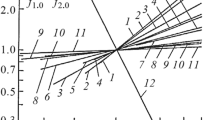Abstract
It is shown that the effective thermal conductivities of a gas measured by steady-state and transient methods are not equal.
Similar content being viewed by others
Literature cited
J. J. De Groot, J. Kestin, and H. Sookiazian, “Instrument to measure the thermal conductivity of gases,” Physica,75, 454–470 (1975).
A. A. Clifford, J. Kestin, and W. A. Wakeham, “Thermal conductivity of N2, CH4, and CO2 at room temperature and pressure up to 35 MPa,” Physica,97A, No. 3, 287–295 (1979).
J. W. Haarman, Een nauwkeurige methode voor het bepalen van de warmtegeleidings-coëfficiënt van gassen (De niestationaire draadmethode), Delft (1969), p. 250.
I. Mashtovskii, “Thermal conductivity of mixtures of helium and xenon at high temperatures,” Inzh.-Fiz. Zh.,32, No. 4, 635–641 (1977).
D. I. Collins, R. Greif, and A. E. Bryson, “Measurements of the thermal conductivity of helium in the temperature range 1600–6700°K” Int. J. Heat Transfer,8, 1209–1216 (1965).
N. B. Vargaftik and Yu. D. Vasilevskaya, “Thermal conductivity of krypton and xenon at high temperatures up to 5000°K,” Inzh.-Fiz. Zh.,39, No. 5, 852–858 (1980).
N. B. Vargaftik and Yu. D. Vasilevskaya, “High-temperature thermal conductivity of neon up to 5000°K and argon up to 6000°K,” Inzh.-Fiz. Zh.,40, No. 3, 473–481 (1981).
N. B. Vargaftik and Yu. D. Vasilevskaya, “Thermal conductivity of helium at temperatures of 300–6000°K,” Inzh.-Fiz. Zh.,42, No. 3, 412–417 (1982).
S. R. De Groot, Thermodynamics of Irreversible Processes [Russian translation], GITTL, Moscow (1956).
L. D. Landau and E. M. Lifshits, Mechanics of Continuous Media [in Russian], GITTL, Moscow (1953).
D. I. Collins and V. A. Menard, “Measurement of the thermal conductivity of inert gases in the temperature range from 1500 to 5000°K,” Teploperedacha, Ser. C, No. 1, 56–59 (1966).
E. F. Smiley, The Measurement of the Thermal Conductivity of Gases at High Temperatures with Shocktube; Experimental Results in Argon at Temperatures between 1000°K and 3000°K, Ph. D. thesis, The Catholic University of America (1957), Washington, p. 132.
R. A. Matula, “Thermal conductivity of rarefied gases and gas mixtures at high temperatures,” Teploperedacha, Ser. C, No. 3, 40–49 (1968).
R. C. Balescu, Equilibrium and Non-Equilibrium Statistical Mechanics, Wiley (1975).
N. B. Vargaftik, L. P. Filippov, A. A. Tarzimanov, and E. E. Totskii, Thermal Conductivity of Liquids and Gases [in Russian], Standartov, Moscow (1978).
Author information
Authors and Affiliations
Additional information
Translated from Inzhenerno-Fizicheskii Zhurnal, Vol. 43, No. 5, pp. 804–807, November, 1982.
Rights and permissions
About this article
Cite this article
Abramenko, T.N. Thermodynamic analysis of the reasons for the difference between the values of the thermal conductivities of gases as measured by steady-state and transient methods. Journal of Engineering Physics 43, 1268–1271 (1982). https://doi.org/10.1007/BF00826551
Received:
Issue Date:
DOI: https://doi.org/10.1007/BF00826551



